|
FAQs on Anemone Identification
39
Related Articles: Anemones,
Bubble
Tip Anemones, LTAs, Cnidarians, Coldwater Anemones, Colored/Dyed Anemones,
Related FAQs: Anemone ID 1, Anemone ID 2, Anemone ID 3, Anemone ID
4, Anemone
ID 5, Anemone ID
6,
Anemone ID 7,
Anemone ID 8,
Anemone ID 9, Anemone ID 10,
Anemone ID
11,
Anemone ID 12, Anemone ID 13, Anemone ID 14, Anemone ID 15,
Anemone ID
16, Anemone ID 17, Anemone ID 18, Anemone ID 19,
Anemone ID 20,
Anemone ID 21, Anemone ID 22, Anemone ID 23, Anemone ID 24, Anemone ID 25, Anemone ID 26, Anemone ID 27, Anemone ID 28, Anemone ID 29, Anemone
ID 30, Anemone ID 31,
Anemone ID 32,
Anemone ID 33,
Anemone ID 34, Anemone ID 35,
Anemone ID 36, Anemone ID 37, Anemone ID 38, Anemone ID 40, Anemone ID 41,
Anemone ID 42,
Anemone ID 43, Anemone ID 44,
Anemone ID 45,
&
Cnidarian
Identification,
|
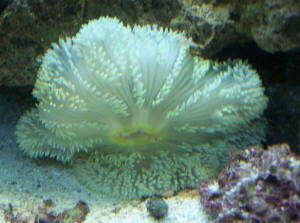
|
 |
New Print and
eBook on Amazon:
Anemone Success
Doing what it takes to keep Anemones healthy long-term
by Robert (Bob) Fenner
|
|
Identifying very young
anemone (Aiptasia?) 3/21/11
I have something resembling Aiptasia sprouting out of my young
live rock.
I read Bob Fenner's excellent article on Aiptasia here, and
learned a lot.
But looking at pictures and reading descriptions is not a good
way for a person like me, who does not know what to look for, to
identify something.
I wonder if there are definitive characteristics of young
anemones.
<Mmm, yes... the shape, size of tentacles; if these vary...
the mouth, shape/size of column, presence of verrucae,
stickiness, colour...>
Actually, if this is an anemone of ANY type I don't want it
in my FOWLR tank, right?
<Likely so>
On the other hand, even though I can easily pull the rock and
pour boiling water on the thing, I hesitate to indiscriminately
kill anything.
It has the characteristic light brown, almost translucent tapered
tentacles, about 3/4 inch long right now, growing slowly.
But there are several things about it that don't quite
fit:
1) The anemone photos show a large tube with the tentacles
surrounding the edge of the tube. But this thing has no such
tube. All of the tentacles radiate from a single holdfast on the
surface of the rock. Is this how a young anemone looks, or does
this rule out an anemone?
<Could be an Anemone... or a Zoanthid... or a single stony
coral polyp that has yet to generate much of a
skeleton...>
2) There are several of them nearby. One has about a half-dozen
tentacles, one is just a single tentacle attached to the rock,
and another is just two. Do young anemones start out this
way?
<Some can>
3) I read that they have a 'pull back' reaction if
touched. But I lightly prodded it with a plastic probe and it has
no reaction at all.
<Some species are relatively insensitive to touch>
What do you think? Should I watch and wait? Or just pull the rock
and hit it with boiling water?
Thanks! Tim
<I'd wait, observe, enjoy for now. Unless these animals
are obviously stinging your fish livestock, they're not
likely trouble. Oh, do send along some well-resolved photos when
you can. Bob Fenner>
Re: Identifying very
young anemone (Aiptasia?) 3/21/11
Bob - Thank you for the reply! This thing is so small that
it's hard to get a good picture, but I have attached the best
one I could get. The item in question is the tuft of light brown
tendrils at the upper-right of the photo.
<Bizarre...>
If you think there is any chance at all that this is Aiptasia,
I'd like to get it out now, because as of the moment it is on
only one small area of one rock. I'd like to attack before it
spreads. But if you think it's
not, or if you think immanent spreading is unlikely, I'll
just let it go and keep watch.
<... I'd like to snip a piece off and take a look-see
under a scope... to me this looks like some sort of aberrant
red(dish) algae more than anything else>
By the way, do you have any idea what that cute little green
stalk in the lower-left of the photo might be?
<Yes... a green... Neomeris spp., maybe N. annulata>
Also by the way, I bought and am reading "The Conscientious
Marine Aquarist" and I just ordered your invertebrate book.
Excellent!
Tim
<Thank you Tim. BobF>
|
|
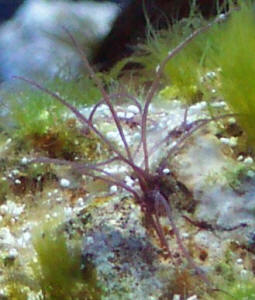 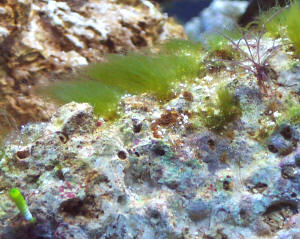
|
Re: Identifying very
young anemone (Aiptasia?) 3/21/11
>> I'd like to snip a piece off and take a look-see under
a scope <<
Bob - Well, if you thought it would keep through the mail, I'd
be happy to mail you a piece. Let me know.
<Mmm, do take a quick read here: http://wetwebmedia.com/microscopfaqs.htm>
I do have a decent microscope, but I have no idea what to look
for.
Unfortunately, it's an old-fashioned scope with no attached
digital camera, so I can't send you a photo. I do want to buy
one of those some day. More toys!
<As you'll see the "QX" series of scopes is really
affordable... I have/use one.>
Anyhow, you seem fairly confident that it's not Aiptasia, so
I'll just let it go. When it gets significantly bigger I'll
send another photo, and maybe it will be more clear then.
<If it's akin to some things I've seen like this before,
it will stay the same size, perhaps laterally multiply. Not
detrimental chemically or physically>
My inexperienced gut tells me that it's a plant, even though
it's not green. Just the way all of those tendrils converge to
a single holdfast point makes it resemble a plant.
Tim
<Cheers, BobF>
Re: Identifying very young anemone (Aiptasia?)
3/22/11
Bob - Well, you inspired me to buy another toy. :) I did an online
search for computer microscopes, and I found one that costs about
twice what a QX costs but has much higher digital resolution (the
CCD sensor). As my long-suffering wife knows all too well, I tend
to solve problems by throwing money at them. Anyhow, when it
arrives I'll snip a piece of that mystery thing and try my hand
at a photo-micrograph of it, and send it to you.
Tim
<Sounds good. Thank you, BobF> |
|
Help with ID of
anemone 2/26/11
Dear WWM crew
<Esther>
Could you please help me indentify this polyp, or tell me where
to look for information? It is for a class. This picture was
taken in the West Coast of Canada.
Thanks
<Looks to be Metridium senile. Bob Fenner>
|
|
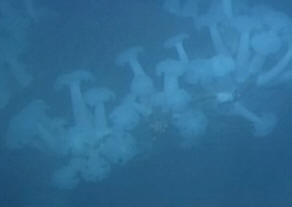
|
|
Unidentified anemone
1/22/11
Hi to all WWW crew!
<Cath>
Here's, in joined pieces, a pic of a fellow reefer of my area
anemone. I did some search and never found what species it is.
Any idea?
<Mmm, likely an Actineria, possibly an Actinodendron sp..
Please see my pix here: http://wetwebmedia.com/anempt2.htm
and these genera on the Net>
Thanks for your help and have a nice day!:-)
Regards.
Cath
<And you, Bob Fenner>
|
|
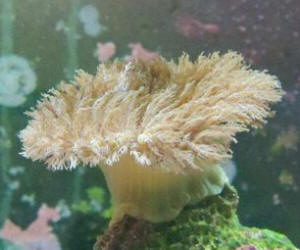
|
|
Re : Unidentified anemone
1/23/11
Thanks a lot Mr. Fenner! ;o)
Cath
<Welcome! BobF>
|
|
Anemone ID
12/29/10
Hey Guys
I have been a big fan of your site for long.
I m posting this question on behalf of my friend.
He recently bought a rock full of coral( I think its
anemone).
<I think so too>
And the tank is currently FOWLR which at some point is going to
be a Reef Tank.
Do you guys think its Majano Anemone ?
<May well be among the genus Anemonia... but as long as they
can be kept isolated on the one rock... "One person's
trash may well be another's treasure". Cheers, Bob
Fenner>
|
|
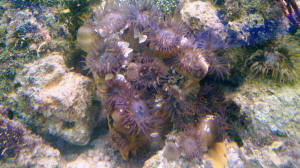 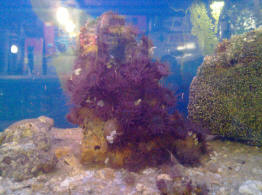
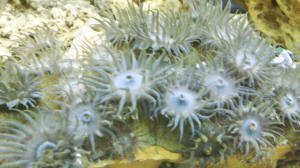
|
|
Unknown anemone
12/19/10
Hi, I have an unknown hitchhiker anemone species. My first
thought was that it was a less common species of Aiptasia but now
I'm wondering (please see attached pictures)
<Beauties!>
They hitched in on a rock with some Codium algae and there are a
dozen or so on a rock 3" square, so likely a pest species. I
have them in a separate tub so they don't cause problems in
my tank until I can get a definite id.
Thanks for you help.
<I don't know what these are... You might send your pix to
Daphne Fautin (at Hexacorallians of the world.com). But if these
are not causing troubles... I'd keep them. Thank you for
sharing. Bob Fenner>
|
|
[1]%20anem.jpg)
[1]%20anems.jpg)
|
|
Anemone Identification
12/3/10
Hello Crew! Thank you for providing this service for those of us
that have hit dead end with every other method of research.
<Welcome~!>
I recently ordered a sebae anemone from a very reputable shop.
What I received was a beautiful specimen, but not something I
have ever seen or would have identified as a sebae.
<Me neither>
I checked with the shop and they verified it as a sebae,
<Not Heteractis crispa assuredly>
and treated me as if I am stupid, which I know I am not. I went
on with my week and have been alarmed a number of times by
it's behaviors. It is often full and beautiful in the
morning, but in the afternoon will shrivel as if it's dying.
It fills back out in the evening and is shriveled again by 9:00
or 10:00pm. I also have yet to see it eat, and it has been 6 days
now. I've tried feeding it a variety of meaty foods, and the
food sticks to the short tentacle but I see no locomotion moving
it toward the mouth.
Even checking 15 and 30 minutes later pieces of krill, shrimp, or
squid will remain in the tentacles. At this point my efforts to
identify are not in knowing what it is, but in knowing how to
care for it, what it needs,
and what to expect in behaviors. It's a truly beautiful
creature, and I would like to enjoy it rather than worry about
it. Thanks for your help!
Derek
<Well... this specimen is aberrant, but my best guess is that
it's a Stichodactyla... likely a S. haddoni. Please do see
here:
http://wetwebmedia.com/carpetanemones.htm
I do hope this specimen rallies for you. Bob
Fenner>
|
|

|
|
|

